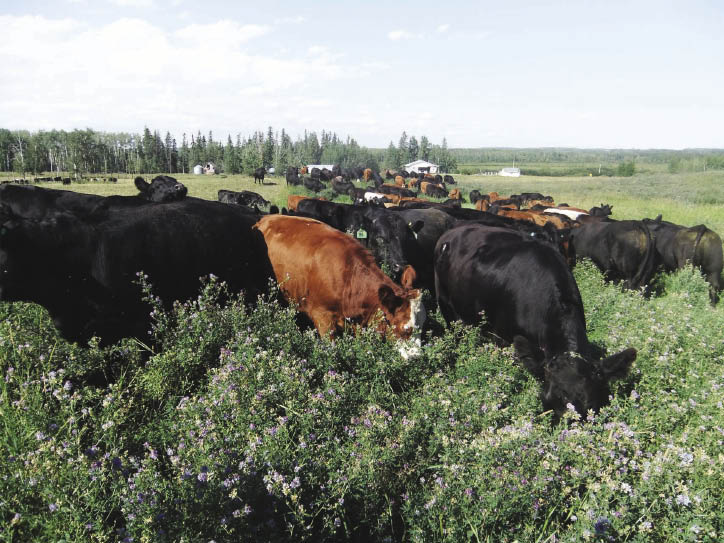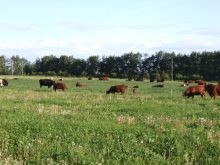That’s my cure for bloat
I was home alone tonight and prepared myself a nice healthy supper. The problem was I was very hungry and my All Natural Grass-Fed Beef Stir Fry just would not cook quickly enough for my hunger bugs. No kids around and the homemade chocolate chip mint ice cream was calling out for me. Just a bit won’t hurt. The kids will never know right? But I resisted the temptation! I have a rule at Greener Pastures that even the cattle have to obey. Never eat your dessert first. Let me explain.
Read Also

Body condition, nutrition and vaccination for brood cows
One of the remarkable events of the past century related to ranching has been the genetic evolution of brood cows….
I believe that we have more economic losses in ranching today from our fear of bloat, than we would ever get from bloat! We eagerly spend thousands and thousands of dollars every year on fertilizer because we are afraid to use legumes in our pastures. For 20 years we have been buying nitrogen fertilizer when we could have been getting it for free all along. The air we breathe is 78 per cent nitrogen. Legumes can get it for you for free! But we are so scared a couple of animals might die of bloat, we don’t use them. If we would have started using legumes 20 years ago, those bloat-sensitive genetics would be long gone out of our herds and their offspring would have never existed. So what do we have to gain? We would have more bloat-resistant cattle, healthier land and more jingle in our pockets. Hey, it is never too late to start.
Let’s back up a bit. A legume is a type of plant that forms a symbiotic relationship with soil microbes to produce nitrogen. The legume gives the microbe a molecule of sugar in return for a molecule of nitrogen, a fair trade all around. Both the plant and the bug benefit and no one gets hurt. OK, except for maybe our poor genetically deficient bloat-sensitive cow. Bloat occurs when a ruminant animal has a change of diet too quickly. If the rumen bugs cannot adjust inside the rumen fast enough, the change in diet causes the fermentation gases to accumulate in the rumen. It forms foam that prevents the animal from being able to burp up the gases. The rumen expands and this could lead to the animal’s death. Oops! OK, so maybe someone could get hurt; I guess that is the reason we are all scared to death of legumes.
Examples of legumes that can cause bloat are alfalfa, sweet clover, red clover, alsike clover and white clover. However, we do have some other choices. Bird’s-foot trefoil, sainfoin and cicer milkvetch are examples of non-bloat legumes. They still produce nitrogen but do not cause issues in the rumen. Your choice for which legume to use in your mix can depend on environment, weather, management and production of the forage stand desired. I actually prefer a combination but you need to determine which is best suited for your environment under your conditions. I recommend a legume-grass mixture over a pure legume stand as monocultures are not natural. Did you know that caragana, buffaloberry and Indian sea buckthorn are also legumes?
So how do you avoid a wreck? There are a few management steps you can take to reduce your risk of bloat. I am assuming in this article that you are managing your pastures with a high stock density rotational grazing system. If you are still continuous grazing, then the last three years of my articles have been a waste of your time. You should turn the page.
For me, the most important thing you need to do to avoid bloat in a high-percentage legume paddock is to maintain a constant diet for the animals. If you have the same quality of forage in the rumen every day, then your risk is very low.
I also encourage you not to be the early bird. When grazing legumes, the early bird gets the wreck! It is better to move the animals on to a new piece of pasture in the afternoon. Ruminants are more susceptible to bloat in the morning because of differences within the plant due to nighttime respiration. The daylight causes the plants to switch back to photosynthesis, which reduces the risk of bloat after a few hours of sunlight.
Never move in the morning. I also never move cattle when they are hungry. Make sure you leave lots of residue so when you move them their rumens are full. It is also advisable not to move cattle when the plants are wet as they break down quicker when wet from rain or dew early in the morning.
The maturity of the plants is another important factor in reducing your bloat risk. The more mature the plants, the less the risk. Grazing in the vegetative stage is more risky than the full-bloom stage.
Also, allowing animals to graze just the leaves of the legume increases the risk. If cattle are made to eat the leaves and the stem together, you should have no problems.
Let’s put this into action. Never let them eat their dessert first.
Day 1: My herd is on a grass pasture and we are moving on to a high-percentage legume pasture. First, sleep in. Let the cattle eat all morning on the grass pasture (the main course) to fill their rumen, and make sure there is plenty of forage left in this paddock. (If you have the option, move them to a paddock that has the least amount of legume.) Now we use some electric fence and only give them a small piece of the new legume paddock (dessert) in the afternoon. Ration off a half-day’s ration but still allow them to go back to the first paddock.
Day 2: If you are quite worried about bloat because of your type of cattle, stage of plant maturity, moisture on the plants or if it will just help you sleep better, you can repeat the steps of Day 1 again for Day 2. If I’m not so worried, I skip Day 2. Just make sure you have plenty of forage in the first paddock still. This is allowing the rumen bugs to adjust to the new type of forage gradually.
Day 3: Sleep in again and let them fill up on the main course. Then go move the cattle into the rest of the new legume paddock in the afternoon. You also have the option of feeding them some roughage before they move on to a new legume paddock as well. Giving them a hay bale in the morning will help make up the main course if your first paddock is grazed down too much. Just make sure they are not hungry going into the new legume paddock. Allowing one or two days to adjust the microbiology within the rumen will reduce your risk of bloat a great deal.
Now that we are on a legume pasture, we just need to maintain a constant ration. Daily moves work best for me. I move the cattle from paddock to paddock every afternoon. This allows them to eat the stems and grasses all morning from yesterday’s paddock, and then they are turned into the new paddock in the afternoon where they eat the best of the best. Let them top up with dessert. Daily moves in the afternoon are your best defence against bloat.
If you are not able to move daily but still have high legume pastures to graze, then you need to adjust the rumen every time you move. For example, if you are moving every four days, the cattle will eat all the best forage at the beginning and leave the poorer quality for the last day. If you just move a herd on to a lush paddock of legumes on Day 4, you could have a wreck. If this is the case, come down on Day 3 and give them a small piece of the next legume paddock, then let them finish up on the first paddock. Let the rumen adjust. Now you are safe to move into the next legume paddock on Day 4 in the afternoon.
There are lots of factors that can cause bloat but the most important tool you have in preventing it is management. Learn how to manage legume pastures and include them in your pasture stands. It is great for your land, your cattle and your bottom line. Free nitrogen is a good thing. No? OK, supper is over. Time for ice cream!

















